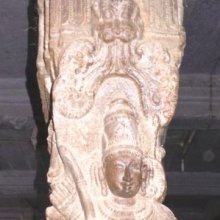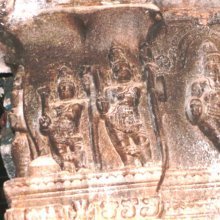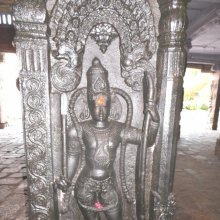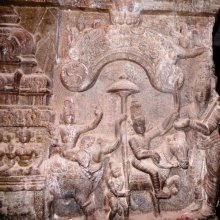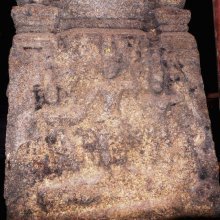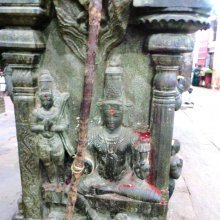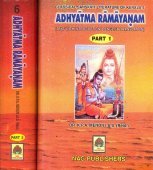Lakshmana, Lakṣmaṇa, Lakṣmaṇā: 35 definitions
Introduction:
Lakshmana means something in Hinduism, Sanskrit, Jainism, Prakrit, the history of ancient India, Hindi, biology. If you want to know the exact meaning, history, etymology or English translation of this term then check out the descriptions on this page. Add your comment or reference to a book if you want to contribute to this summary article.
The Sanskrit terms Lakṣmaṇa and Lakṣmaṇā can be transliterated into English as Laksmana or Lakshmana, using the IAST transliteration scheme (?).
Images (photo gallery)
(+31 more images available)
In Hinduism
Natyashastra (theatrics and dramaturgy)
Source: archive.org: The mirror of gesture (abhinaya-darpana)One of the Hands of Famous Emperors.—For Lakṣmana, the Śikhara hand on the left shoulder.

Natyashastra (नाट्यशास्त्र, nāṭyaśāstra) refers to both the ancient Indian tradition (shastra) of performing arts, (natya—theatrics, drama, dance, music), as well as the name of a Sanskrit work dealing with these subjects. It also teaches the rules for composing Dramatic plays (nataka), construction and performance of Theater, and Poetic works (kavya).
Purana and Itihasa (epic history)
Source: Wisdom Library: Bhagavata PuranaLakṣmaṇa (लक्ष्मण):—Son of Daśaratha (son of Aja). He was an incarnation who appeared to his father in the form of a son. (see Bhāgavata Purāṇa 9.10.2)
Source: archive.org: Puranic Encyclopedia1) Lakṣmaṇa (लक्ष्मण).—Son born to Daśaratha of Sumitrā. Short history. Since details about Lakṣmaṇa are included in the story under 'Rāma' only a short description is given below:
Daśaratha, King of Ayodhyā had three wives, Kausalyā, Kaikeyī and Sumitrā. To obtain children Daśaratha performed a sacrifice named Putrakāmeṣṭi requesting the great sage Ṛṣyaśṛṅga to officiate at the ceremony. At the close of the ceremony a divine person rose up from the sacrificial fire with a pot of pudding and all the three wives became pregnant by eating the same. Kausalyā gave birth to Śrī Rāma, Kaikeyī to Bharata and Sumitrā to Lakṣmaṇa and Śatrughna. Lakṣmaṇa was an incarnation of Ananta and so Rāma and Lakṣmaṇa had more attachment to each other. (See full article at Story of Lakṣmaṇa from the Puranic encyclopaedia by Vettam Mani)
2) Lakṣmaṇa (लक्ष्मण).—A very brave son of Duryodhana. He was a great archer. The Mahābhārata gives the following information about him.
2) (i) In the great battle Abhimanyu defeated this Lakṣmaṇa. (Śloka 32, Chapter 73, Bhīṣma Parva).
2) (ii) Lakṣmaṇa fought against Kṣatradeva. (Śloka 49, Chapter 14, Droṇa Parva).
2) (iii) Abhimanyu killed him in the battle-field. (Śloka 17, Chapter 46, Droṇa Parva).
2) (iv) After the great war when once, at the request of Kuntī and Gāndhārī, Vyāsa by his yogic powers arrayed the dead warriors for Kuntī and Gāndhārī to see, this Lakṣmaṇa was also among them. (Śloka 11, Chapter 32, Āśramavāsika Parva).
3) Lakṣmaṇā (लक्ष्मणा).—One of the queens of Śrī Kṛṣṇa. (Chapter 33, Sabhā Parva, Dākṣiṇātyapāṭha).
Source: archive.org: Shiva Purana - English TranslationLakṣmaṇa (लक्ष्मण) (partial incarnation of Śeṣa) together with Rāma are two sons of Daśaratha born of the Sūryavaṃśa dynasty, according to the Śivapurāṇa 2.2.24. Accordingly as Brahmā narrated to Nārada:—“[...] once Śiva accompanied by Satī and seated on His Bull wandered over the Earth, in one of his sportive activities. Wandering over the ocean-girt Earth He reached Daṇḍaka forest [...] There Śiva saw Rāma who was searching for Sitā who was deceitfully abducted by Rāvaṇa. Lakṣmaṇa too was there. [...]”.
Lord Śiva said: “[...] O Goddess [Satī], they are two brothers Rāma and Lakṣmaṇa. They are heroic, intelligent sons of Daśaratha, born of the solar dynasty. The fair-complexioned one is the younger brother Lakṣmaṇa. He is the partial incarnation of Śeṣa. The elder one is the complete incarnation of Viṣṇu. He is called Rāma. He is incapable of being harassed. The lord has incarnated on the Earth for our welfare and the protection of the good”.
Source: Cologne Digital Sanskrit Dictionaries: The Purana Index1a) Lakṣmaṇa (लक्ष्मण).—A son of Daśaratha and younger brother of Rāma;1 took part in the Lankā expedition; respected the Brahmaṇas and elders; present at Rāma's coronation; father of Angada and Citraketu,2 whose cities were Korayaṇa and Candracakra, near the Himālayas; created with Rāma by Lalitā, he killed Meghanāda in Bhaṇḍāsura war.3
- 1) Bhāgavata-purāṇa IX. 10. 3; V. 19. 1 and 6.
- 2) Ib. IX. 10. 19, 41-7; 11. 12; Brahmāṇḍa-purāṇa III. 37. 31; 63. 185; Vāyu-purāṇa 88. 184, 187; 108. 25; Viṣṇu-purāṇa IV. 4. 87, 104.
- 3) Brahmāṇḍa-purāṇa IV. 29. 114.
1b) A mantrakṛt.*
- * Matsya-purāṇa 145. 101.
2a) Lakṣmaṇā (लक्ष्मणा).—A daughter of the king of the Madras; heard of Kṛṣṇa's glory from Nārada and set her mind on him. It was arranged that in a svayaṃvara he, who hit a target (fish) correctly by looking at its reflection in the water below was to wed her. All tried in vain but Kṛṣṇa succeeded and married her; when she was taken in a chariot, other kings attacked Kṛṣṇa; he vanquished all of them, and reached Dvārakā. Addressed Draupadī at length on her marriage;1 sons, Gātravat and others.2
- 1) Bhāgavata-purāṇa X. 58. 57; 83. 6, 17-39; Matsya-purāṇa 47. 13; Vāyu-purāṇa 96. 234; Viṣṇu-purāṇa V. 28. 5.
- 2) Ib. V. 32. 4.
2b) A daughter of Duryodhana married by Sāmba in a svayaṃvara. For this the Kurus like Karṇa and Duryodhana took him captive after a severe fight and threw him into prison. Afraid of Balarāma's prowess, Duryodhana agreed to her marriage with Sāmba and sent a rich dowry.*
- * Bhāgavata-purāṇa X. 68. 1-12, 43-51.
2c) An Apsaras.*
- * Brahmāṇḍa-purāṇa III. 7. 7.
Lakṣmaṇa (लक्ष्मण) refers to one of the four sons of Daśaratha who is the grandson of Raghu, according to the Vaṃśānucarita section of the 10th century Saurapurāṇa: one of the various Upapurāṇas depicting Śaivism.—Accordingly, [...] Raghu was the son of Dīrghabāhu. The son of Raghu was very famous from whom Daśaratha was born. Daśaratha had four sons who were religious and famous in the world. They were Rāma, Bharata, Lakṣmaṇa and Śatrughna. All of them were devoted to Lord Mahādeva. [...] When Rāma was about to be consecrated, his step mother Kaikeyī asked for two boons to Daśaratha to grant which he promised earlier. As a result Bharata became the king, Rāma, Lakṣmaṇa were sent to the forest along with Sītā.

The Purana (पुराण, purāṇas) refers to Sanskrit literature preserving ancient India’s vast cultural history, including historical legends, religious ceremonies, various arts and sciences. The eighteen mahapuranas total over 400,000 shlokas (metrical couplets) and date to at least several centuries BCE.
Ayurveda (science of life)
Rasashastra (Alchemy and Herbo-Mineral preparations)
Source: Wisdom Library: Rasa-śāstraLakṣmaṇā (लक्ष्मणा):—One of the sixty-seven Mahauṣadhi, as per Rasaśāstra texts (rasa literature). These drugs are useful for processing mercury (rasa), such as the alchemical processes known as sūta-bandhana and māraṇa.
Nighantu (Synonyms and Characteristics of Drugs and technical terms)
Source: WorldCat: Rāj nighaṇṭuLakṣmaṇā (लक्ष्मणा) is another name for Śvetakaṇṭakārī, a medicinal plant related to Kaṇṭakārī, according to verse 4.33-36 of the 13th-century Raj Nighantu or Rājanighaṇṭu. The fourth chapter (śatāhvādi-varga) of this book enumerates eighty varieties of small plants (pṛthu-kṣupa). Together with the names Lakṣmaṇā and Śvetakaṇṭakārī, there are a total of twenty-four Sanskrit synonyms identified for this plant.
Veterinary Medicine (The study and treatment of Animals)
Source: Shodhganga: Portrayal of Animal Kingdom (Tiryaks) in Epics An Analytical studyLakṣmaṇa (लक्ष्मण) (lit. “one having a particular mark”) is a synonym (another name) for the Sārasa, according to scientific texts such as the Mṛgapakṣiśāstra (Mriga-pakshi-shastra) or “the ancient Indian science of animals and birds” by Hamsadeva, containing the varieties and descriptions of the animals and birds seen in the Sanskrit Epics such as the Ramayana and Mahabharata.
Toxicology (Study and Treatment of poison)
Source: Shodhganga: Kasyapa Samhita—Text on Visha ChikitsaLakṣmaṇa (लक्ष्मण) is the name of an ingredient used in the treatment of Rājilā-snake-bites, according to the Kāśyapa Saṃhitā: an ancient Sanskrit text from the Pāñcarātra tradition dealing with both Tantra and Viṣacikitsā—an important topic from Āyurveda which deals with the study of Toxicology (Viṣavidyā or Sarpavidyā).—The tenth Adhyāya prescribes antidotes for Rājilā snake venom.—According to the Kāśyapasaṃhitā verse X.33b-38a: “[...] Śūlī, Dark ulasī, Jīvantī, kuṣṭhā, Cinnamon, Lakṣmaṇa, Maṇḍūkī, Sūtavārtākī and Paṭola can be given as side dish. These along with clove and Horsegram, Śigru and Neem totally destroy poison. Bovine milk, butter-milk, ghee and Buffalo-curd and buttermilk and ghee also are highly recommended in the Agada treatment. Trikaṭu must be consumed after food”.
Unclassified Ayurveda definitions
Source: Wisdom Library: Āyurveda and botanyLakṣmaṇā (लक्ष्मणा) is a Sanskrit word [probably] referring to Ipomoea sepiaria, a plant in the Convolvulaceae family. Certain plant parts of Lakṣmaṇā are eaten as a vegetable (śāka), according to Caraka in his Carakasaṃhitā sūtrasthāna (chapter 27), a classical Ayurvedic work. The plant is therefore part of the Śākavarga group of medicinal plants, referring to the “group of vegetables/pot-herbs”. Caraka defined such groups (vargas) based on the dietic value of the plant.
Source: archive.org: Science And Technology In Medievel India (Ayurveda)Lakṣmaṇa (लक्ष्मण) or Lakṣmaṇakalpa is the name of a chapter of the Kalpalatā, as mentioned in A. Rahman’s Science and Technology in Medievel India: A bibliography of source materials in Sanskrit, Arabic and Persian.—Ancient and medieval India produced a wide range of scientific manuscripts and major contributions lie in the field of medicine, astronomy and mathematics, besides covering encyclopedic glossaries and technical dictionaries.—The Kalpalatā deals with the preparation of medicine [e.g., Lakṣmaṇa-kalpa] from various plants.

Āyurveda (आयुर्वेद, ayurveda) is a branch of Indian science dealing with medicine, herbalism, taxology, anatomy, surgery, alchemy and related topics. Traditional practice of Āyurveda in ancient India dates back to at least the first millenium BC. Literature is commonly written in Sanskrit using various poetic metres.
Vaishnavism (Vaishava dharma)
Source: ISKCON Press: Glossary1) Lakṣmaṇa (लक्ष्मण).—A very brave son of Duryodhana. He was killed by Abhimanyu during the battle of Kurukṣetra.
2) Lakṣmaṇa (लक्ष्मण).—A younger brother of Lord Rāmacandra’s. An incarnation of Saṅkarṣaṇa, He accompanied Rāma and Sītā in Their exile.

Vaishnava (वैष्णव, vaiṣṇava) or vaishnavism (vaiṣṇavism) represents a tradition of Hinduism worshipping Vishnu as the supreme Lord. Similar to the Shaktism and Shaivism traditions, Vaishnavism also developed as an individual movement, famous for its exposition of the dashavatara (‘ten avatars of Vishnu’).
Kavya (poetry)
Source: Wisdom Library: Kathāsaritsāgara1) Lakṣmaṇa (लक्ष्मण) is the younger brother of Rāma, both sons of Daśaratha, the king of Ayodhyā, according to in the Kathāsaritsāgara, chapter 51. Accordingly, “... long ago king Daśaratha, the sovereign of Ayodhyā, had a son named Rāma, the elder brother of Bharata, Śatrughna and Lakṣmaṇa. He was a partial incarnation of Viṣṇu for the overthrow of Rāvaṇa, and he had a wife named Sītā, the daughter of Janaka, the lady of his life. As fate would have it, his father handed over the kingdom to Bharata, and sent Rāma to the forest with Sītā and Lakṣmaṇa”.
2) Lakṣmaṇa (लक्ष्मण) and Rāma were the twin-sons born to king Tārāvaloka and Mādrī, according to the Kathāsaritsāgara, chapter 113. Accordingly, as Kaśyapa said to Naravāhanadatta: “... then he [Tārāvaloka] had two twin sons born to him by Mādrī, and the father called them Rāma and Lakṣmaṇa. And the boys grew like the love and joy of their parents, and they were dearer than life to their grandparents. And Tārāvaloka and Mādrī were never tired of looking at them, as they bent before them, being filled with virtue, like two bows of the prince, being strung”.
The Kathāsaritsāgara (‘ocean of streams of story’), mentioning Lakṣmaṇa, is a famous Sanskrit epic story revolving around prince Naravāhanadatta and his quest to become the emperor of the vidyādharas (celestial beings). The work is said to have been an adaptation of Guṇāḍhya’s Bṛhatkathā consisting of 100,000 verses, which in turn is part of a larger work containing 700,000 verses.

Kavya (काव्य, kavya) refers to Sanskrit poetry, a popular ancient Indian tradition of literature. There have been many Sanskrit poets over the ages, hailing from ancient India and beyond. This topic includes mahakavya, or ‘epic poetry’ and natya, or ‘dramatic poetry’.
Shilpashastra (iconography)
Source: Shodhganga: The significance of the mūla-beras (śilpa)Lakṣmaṇa is the name of a deity depicted at Ramaswamy Temple in Kumbakonam (Kumbhakonam), representing a sacred place for the worship of Viṣṇu.—(a) In the sannidhi for Rāma, there are icons of Rāma, Sītā, Lakṣmaṇa and Hanumān. [...] Lakṣmaṇa is found standing in samapāda-sthānaka to the right of Rāma with hands in añjali-hasta. (b) In front of the stone images are the utsava-mūrti of Rāma, Sītā, Lakṣmaṇa, Bharata, Satrukguṇa and Hanumān. Lakṣmaṇa is also found in the same pose as Rāma. He is found to the left of Rāma.
The images of Rāma Sītā and Lakṣmana are made out of stone. While depicting in dancing, Rāma and Lakṣmaṇa are found in samapāda-sthānaka with the right hand in kapittha-hasta and the left hand in śikhara-hasta.

Shilpashastra (शिल्पशास्त्र, śilpaśāstra) represents the ancient Indian science (shastra) of creative arts (shilpa) such as sculpture, iconography and painting. Closely related to Vastushastra (architecture), they often share the same literature.
Vedanta (school of philosophy)
Source: Shodhganga: Siva Gita A Critical StudyLakṣmaṇa (लक्ष्मण) or Lakṣmaṇagītā refers to one of the sixty-four Gītās commonly referred to in Hindu scriptures.—Gītā is the name given to certain sacred writings in verse (often in the form of a dialogue) which are devoted to the exposition of particular religious and theosophical doctrines. Most of these Gītās [i.e., Lakṣmaṇa-gītā] originate from the Mahābhārata or the various Purāṇas.

Vedanta (वेदान्त, vedānta) refers to a school of orthodox Hindu philosophy (astika), drawing its subject-matter from the Upanishads. There are a number of sub-schools of Vedanta, however all of them expound on the basic teaching of the ultimate reality (brahman) and liberation (moksha) of the individual soul (atman).
General definition (in Hinduism)
Source: WikiPedia: Hinduism1) Lakshmana was the brother and close companion of Rama, and himself a hero in the famous epic Ramayana. Within a number of Hindu traditions Lakshmana is considered to be an avatar, in a secondary form to Rama's main appearance. In some Hindu traditions he is worshiped as an avatar of Shesha. The name may also be written as Lakshman or Laxman.
Lakshmana is the twin brother of Shatrughna, born in Ayodhya to Sumitra, the third wife of Dasharatha, king of Kosala. Thus, Rama is the eldest, Bharata is the second, Lakshmana is the third, and Shatrughna is the youngest of the four brothers. Despite being the twin of Shatrughna, Lakshmana is specially attached to Rama, and the duo are inseparable. When Rama marries Sita, Lakshmana married the younger sister of Sita named Urmila.
2) Lakshmaṇa (लक्ष्मण): Younger stepbrother of Rama and son of Sumitra and King Dasaratha. Duryodhana's gallant young son also bore this name.
Etymology: Lakshmana (Sanskrit: लक्ष्मण, IAST Lakṣmaṇa; Chinese: Loman; Indonesian and Javanese: Leksmana, Lesmana, Lesmono; Khmer:; Lao:; Malay: Laksamana; Maranaw: Mangawarna; Tamil: லக்ஷ்மணன் ; Thai: พระลักษมณ์)
Source: Vaniquotes: HinduismLakṣmaṇa is the incarnation of Saṅkarṣaṇa
In Jainism
General definition (in Jainism)
Source: Wisdom Library: JainismLakṣmaṇā (लक्ष्मणा) is the mother of Candraprabha according to Śvetāmbara (but she is named Lakṣmī according to Digambara), according to the Ācāradinakara (14th century work on Jain conduct written by Vardhamāna Sūri). Candraprabha is the eighth of twenty-four Tīrthaṅkaras in Janism. A Tīrthaṅkara is an enlightened being who has conquered saṃsāra (cycle of birth and death), leaving behind him a path for others to follow.
The husband of Lakṣmaṇā is Mahasena. It is an ancient Jain practice to worship the Tīrthaṅkara’s parents in various rites, such as the pratiṣṭhāvidhi.
Source: archive.org: Trisastisalakapurusacaritra1) Lakṣmaṇā (लक्ष्मणा) is the wife of king Mahāsena and mother of Candraprabha, according to chapter 3.6 [candraprabha-caritra] of Hemacandra’s 11th century Triṣaṣṭiśalākāpuruṣacaritra: an ancient Sanskrit epic poem narrating the history and legends of sixty-three illustrious persons in Jainism.—Accordingly, “[...] Mahāsena had a wife, named Lakṣmaṇā, who had all the favorable marks, surpassing the moon in fascinating beauty of face. [...] Though possessing a body which was an unequaled stream of loveliness, she rained only nectar with her eye and speech. Walking very slowly, she made blooming mallows grow at every step with her feet, as it were. [...]”.
2) Lakṣmaṇa (लक्ष्मण) or Nārāyaṇa is son of Sumitrā and Daśaratha, according to the Jain Ramayana and chapter 7.4 [Rāma and Lakṣmaṇa].—Accordingly, “Sumitrā saw an elephant, lion, sun, moon, fire, Śrī, and ocean in a dream at dawn, which indicated the birth of a Viṣṇu. Then a powerful god fell from heaven and descended into Queen Sumitrā’s womb. [...] The king gave him the name Nārāyaṇa; he became known over the earth by another name, Lakṣmaṇa”.

Jainism is an Indian religion of Dharma whose doctrine revolves around harmlessness (ahimsa) towards every living being. The two major branches (Digambara and Svetambara) of Jainism stimulate self-control (or, shramana, ‘self-reliance’) and spiritual development through a path of peace for the soul to progess to the ultimate goal.
India history and geography
Source: archive.org: Personal and geographical names in the Gupta inscriptionsLakṣmaṇa (लक्ष्मण) is an example of a name based on Rāma mentioned in the Gupta inscriptions. Lord Rāma is believed to be the seventh incarnation of Viṣṇu. Rāma occurring in our inscriptions seems to have been Rāma Rāghava. The Gupta empire (r. 3rd-century CE), founded by Śrī Gupta, covered much of ancient India and embraced the Dharmic religions such as Hinduism, Buddhism and Jainism. Derivation of personal names (e.g., Lakṣmaṇa) during the rule of the Guptas followed patterns such as tribes, places, rivers and mountains.

The history of India traces the identification of countries, villages, towns and other regions of India, as well as mythology, zoology, royal dynasties, rulers, tribes, local festivities and traditions and regional languages. Ancient India enjoyed religious freedom and encourages the path of Dharma, a concept common to Buddhism, Hinduism, and Jainism.
Biology (plants and animals)
Source: Wisdom Library: Local Names of Plants and DrugsLaksmana [लक्ष्मणा] in the Sanskrit language is the name of a plant identified with Remusatia vivipara (Roxb.) Schott from the Araceae (Arum) family having the following synonyms: Arum viviparum, Colocasia vivipara, Remusatia formosana. For the possible medicinal usage of laksmana, you can check this page for potential sources and references, although be aware that any some or none of the side-effects may not be mentioned here, wether they be harmful or beneficial to health.
Laksmana [लक्षमण] in the Sanskrit language is the name of a plant identified with Cynoglossum lanceolatum Forssk. from the Boraginaceae (Forget-me-not) family having the following synonyms: Cynoglossum canescens, Cynoglossum racemosum.
Laksmana [लक्ष्मणा] in the Sanskrit language is the name of a plant identified with Ipomoea triloba L. from the Convolvulaceae (Morning glory) family.
Lakshmana in the Kannada language is the name of a plant identified with Mandragora officinarum from the Solanaceae (Potato) family.
Laksmana [लक्षमण] in the Sanskrit language, ibid. previous identification.
Lakshmana [लक्ष्मणा] in the Hindi language is the name of a plant identified with Ipomoea obscura (L.) Ker Gawler from the Convolvulaceae (Morning glory) family having the following synonyms: Convolvulus obscurus, Ipomoea fragilis.
Laksmana [लक्ष्मणा] in the Sanskrit language, ibid. previous identification.
Lakshmana [लक्ष्मणा] in the Marathi language is the name of a plant identified with Ipomoea sagittifolia Burm.f. from the Convolvulaceae (Morning glory) family having the following synonyms: Ipomoea sepiaria, Ipomoea maxima, Ipomoea marginata.
Laksmana [लक्ष्मणा] in the Sanskrit language, ibid. previous identification.
Laksmana [లక్ష్మణా] in the Telugu language, ibid. previous identification.
Source: Google Books: CRC World Dictionary (Regional names)1) Laksmana in India is the name of a plant defined with Biophytum umbraculum in various botanical sources. This page contains potential references in Ayurveda, modern medicine, and other folk traditions or local practices It has the synonym Oldenlandia herbacea var. papillosa (Chiov.) Bremek. (among others).
2) Laksmana is also identified with Ipomoea marginata It has the synonym Convolvulus marginatus Desr. (etc.).
3) Laksmana is also identified with Ipomoea obscura It has the synonym Convolvulus trichocalyx Schumach. & Thonn. (etc.).
4) Laksmana is also identified with Oxalis sessilis It has the synonym Biophytum apodiscias (Turcz.) Edgew. & Hook. f. (etc.).
5) Laksmana is also identified with Panax quinquefolius It has the synonym Ginseng quinquefolium (L.) Alph. Wood (etc.).
6) Laksmana is also identified with Remusatia vivipara It has the synonym Caladium viviparum Lodd. (etc.).
Example references for further research on medicinal uses or toxicity (see latin names for full list):
· Narrative of Travels and Discoveries in Northern and Central Africa
· The American Botanist and Florist (1871)
· Glycobiology
· Revue Horticole (1854)
· Meletemata Botanica (1832)
· Botanical Cabinet (1820)
If you are looking for specific details regarding Laksmana, for example chemical composition, extract dosage, health benefits, side effects, diet and recipes, pregnancy safety, have a look at these references.

This sections includes definitions from the five kingdoms of living things: Animals, Plants, Fungi, Protists and Monera. It will include both the official binomial nomenclature (scientific names usually in Latin) as well as regional spellings and variants.
Languages of India and abroad
Sanskrit dictionary
Source: DDSA: The practical Sanskrit-English dictionaryLakṣmaṇa (लक्ष्मण).—a. [lakṣman-aṇ na vṛddhiḥ]
1) Having marks.
2) Possessed of good or auspicious marks, fortunate, lucky.
3) Prosperous, thriving.
-ṇaḥ 1 The crane. -2> Name of a son of Dasaratha by his wife Sumitrā. [He was so much attached to Rāma from his very childhood that he became ready to accompany him during his travels, and took no small part in the several events that took place during the fourteen years of Rāma's exile. In the war of Laṇkā he killed several powerful demons, but particularly Meghanāda, the most heroic of the sons of Rāvaṇa. He was at first mortally wounded by Meghanāda by means of a magical weapon, but was restored to life by Suṣeṇa by means of the medicinal durgs fetched by Māruti. One day, Time in the disguise of a hermit came to Rāma and said that he who should happen to see them converse in private should be immediately abandoned, which was agreed to Laksmana on one occasion intruded on their privacy and made the word of his brother true by throwing himself into the Śarayū; (see R.15.92-95.). He married Urmilā by whom he had two sons, Aṅgada and Chandraketu.]; अथ लक्ष्मणानुगतकान्तवपुः (atha lakṣmaṇānugatakāntavapuḥ) Śiśupālavadha 9.31.
-ṇā 1 A goose (sārasā); 'हंसस्य योषिद्वरटा सारसस्य तु लक्ष्मणा (haṃsasya yoṣidvaraṭā sārasasya tu lakṣmaṇā) |' Śiśupālavadha 4.59.
2) A kind of pot-herb.
-ṇam 1 A name, an appellation.
2) A mark, sign, token.
Source: Cologne Digital Sanskrit Dictionaries: Shabda-Sagara Sanskrit-English DictionaryLakṣmaṇa (लक्ष्मण).—mfn.
(-ṇaḥ-ṇā-ṇaṃ) Prosperous fortunate. m.
(-ṇaḥ) 1. The son of Dasarat'Ha by Sumitra, the half-brother and faithful companion of Ramachandra. 2. The Saras or Indian crane. n.
(-ṇaṃ) 1. A mark, a spot or sign. 2. A name, an appellation. f.
(-ṇā) 1. The female of the Saras. 2. A kind of drug. E. lakṣ to mark or see, Unadi aff. na, and muṭ augment. also with aṭ augment, lakṣaṇa .
Source: Cologne Digital Sanskrit Dictionaries: Benfey Sanskrit-English DictionaryLakṣmaṇa (लक्ष्मण).—i. e. lakṣman + a, I. m. 1. The son of Daśaratha by Sumitrā, [Rāmāyaṇa] 3, 50, 24. 2. The Indian crane, [Arjunasamāgama] 9, 21. Ii. f. ṇā, The female of the Indian crane. Iii. n. 1. A mark, a spot, [Śiśupālavadha] 9, 31 (and at the same time Lakṣmaṇa). Comp. Saha-, adj. with Lakṣmaṇa, [Rāmāyaṇa] 3, 52, 2. 2. A name.
Source: Cologne Digital Sanskrit Dictionaries: Cappeller Sanskrit-English DictionaryLakṣmaṇa (लक्ष्मण).—[adjective] having marks or signs.
— [masculine] the Indian crane, [Name] of Rāma’s brother etc.; [feminine] ā [Name] of [several] plants, a woman’s name; [neuter] mark, sign.
Source: Cologne Digital Sanskrit Dictionaries: Aufrecht Catalogus Catalogorum1) Lakṣmaṇa (लक्ष्मण) as mentioned in Aufrecht’s Catalogus Catalogorum:—of the Rāḍhīvaṃśa, father of Jagannātha (Yogasaṃgraha 1617). W. p. 296.
2) Lakṣmaṇa (लक्ष्मण):—son of Śaṅkara Dīkṣita, father of Lallādīkṣita (Mṛcchakaṭikāṭīkā 1821). Oxf. 134^b.
3) Lakṣmaṇa (लक्ष्मण):—poet. [Subhāshitāvali by Vallabhadeva] Padyāmṛtataraṅgiṇī.
4) Lakṣmaṇa (लक्ष्मण):—Guruvaṃśaṭīkā.
5) Lakṣmaṇa (लक्ष्मण):—Cūḍāmaṇisāra jy. Daivajñavidhivilāsa. Ramalagrantha.
6) Lakṣmaṇa (लक्ष्मण):—Paramahaṃsasaṃhitā.
7) Lakṣmaṇa (लक्ष्मण):—Samasyārṇava.
8) Lakṣmaṇa (लक्ष्मण):—son of Datta, pupil of Nāganātha and Nārāyaṇa: Yogacandrikā med. In Bhr. 763 the book is called Vaidyakayogacandrikā.
9) Lakṣmaṇa (लक्ष्मण):—son of Murāri Pāṭhaka: Mahābhāṣyādarśa.
10) Lakṣmaṇa (लक्ष्मण):—father of Manu (Vaidyasarvasva).
11) Lakṣmaṇa (लक्ष्मण):—son of Nṛsiṃha, father of Rāmakṛṣṇa (Līlavatīvṛtti.).
12) Lakṣmaṇa (लक्ष्मण):—Jaiminisūtraṭīkā Jyotiṣpradīpikā jy.
13) Lakṣmaṇa (लक्ष्मण):—with the surname Sāmaga, son of Veṇīmādhava and Rādhā, pupil of Raghunātha: Kitavollāsa. Caṇḍīkucapañcāśikā.
14) Lakṣmaṇa (लक्ष्मण):—son of Datta, grandson of Viśvanātha, pupil of Uttamaśloka: Advaitasudhākalāpa.
15) Lakṣmaṇa (लक्ष्मण):—Jaṭāsiddhāntacandrikā.
16) Lakṣmaṇa (लक्ष्मण):—Padyāmṛtataraṅgiṇī.
17) Lakṣmaṇa (लक्ष्मण):—Bhāminīvilāsabhūṣaṇa.
18) Lakṣmaṇa (लक्ष्मण):—Harihaladharamaṅgala.
Source: Cologne Digital Sanskrit Dictionaries: Monier-Williams Sanskrit-English Dictionary1) Lakṣmaṇa (लक्ष्मण):—[from lakṣ] mf(ā)n. having marks or signs or characteristics, [Taittirīya-saṃhitā]
2) [v.s. ...] endowed with auspicious signs or marks, lucky, fortunate, [cf. Lexicographers, esp. such as amarasiṃha, halāyudha, hemacandra, etc.]
3) [v.s. ...] m. Ardea Sibirica, [Āpastamba]
4) [v.s. ...] Name of a Vāsiṣṭha [gana] śubhrādi
5) [v.s. ...] of a son of Daśa-ratha by his wife Su-mitrā (he was younger brother and companion of Rāma during his travels and adventures; L° and Śatru-ghna were both sons of Su-mitrā, but L° alone is usually called Saumitri; he so attached himself to Rāma as to be called R°’s second self; whereas Śatru-ghna attached himself to Bharata), [Rāmāyaṇa; Purāṇa] etc.
6) [v.s. ...] Name of various authors and other persons (also with ācārya, kavi, deśika, dvivedin, paṇḍita, bhaṭṭa, śāstrin, sūri etc.), [Catalogue(s)]
7) Lakṣmaṇā (लक्ष्मणा):—[from lakṣmaṇa > lakṣ] f. the female of the Ardea Sibirica, [Mahābhārata]
8) [v.s. ...] a goose, [Uṇādi-sūtra iii, 7 [Scholiast or Commentator]]
9) [v.s. ...] a kind of potherb, [Caraka]
10) [v.s. ...] Name of various other plants (Hemionitis Cordifolia; Uraria Lagopodioides; = putra-kandā and a white-flowering Kaṇṭakārī), [cf. Lexicographers, esp. such as amarasiṃha, halāyudha, hemacandra, etc.]
11) [v.s. ...] Name of a wife of Kṛṣṇa, [Harivaṃśa; Purāṇa]
12) [v.s. ...] of a daughter of Dur-yodhana (carried off by Sāmbha, a son of Kṛṣṇa), [Bhāgavata-purāṇa]
13) [v.s. ...] of an Apsaras, [Harivaṃśa]
14) [v.s. ...] of a Buddhist Devī, [Kālacakra]
15) [v.s. ...] of the mother of the 8th Arhat of the present Avasarpiṇī, [cf. Lexicographers, esp. such as amarasiṃha, halāyudha, hemacandra, etc.]
16) Lakṣmaṇa (लक्ष्मण):—[from lakṣ] n. a mark, sign, token, [Mahābhārata; Rāmāyaṇa] etc. (often [varia lectio] lakṣaṇa), a name, [cf. Lexicographers, esp. such as amarasiṃha, halāyudha, hemacandra, etc.]
17) Lākṣmaṇa (लाक्ष्मण):—mf(ī)n. ([from] lakṣmaṇa) relating to the plant Lakṣmaṇā, [Vāgbhaṭālaṃkāra]
18) a [patronymic] [from] lakṣmaṇa, [Saṃskārakaustubha]
Source: Cologne Digital Sanskrit Dictionaries: Yates Sanskrit-English DictionaryLakṣmaṇa (लक्ष्मण):—[(ṇaḥ-ṇā-ṇaṃ) a.] Happy, fortunate. m. The son of Dasaratha by Sumitrā; Indian crane. n. Mark; name. f. A crane; a drug.
Source: DDSA: Paia-sadda-mahannavo; a comprehensive Prakrit Hindi dictionary (S)Lakṣmaṇa (लक्ष्मण) in the Sanskrit language is related to the Prakrit words: Lakkhamāṇa, Lakhamaṇa.
[Sanskrit to German]
Sanskrit, also spelled संस्कृतम् (saṃskṛtam), is an ancient language of India commonly seen as the grandmother of the Indo-European language family (even English!). Closely allied with Prakrit and Pali, Sanskrit is more exhaustive in both grammar and terms and has the most extensive collection of literature in the world, greatly surpassing its sister-languages Greek and Latin.
Hindi dictionary
Source: DDSA: A practical Hindi-English dictionaryLakṣmaṇa (लक्ष्मण) [Also spelled lakshman]:—(nm) a younger brother of Ram in the ancient Indian epic of Ramayan; -[rekhā] in the epic Ramayan, the line drawn by Lakshman bidding Sita: rot to cross it for her own security.
...
Kannada-English dictionary
Source: Alar: Kannada-English corpusLakṣmaṇa (ಲಕ್ಷ್ಮಣ):—
1) [noun] that which has a or some characteristic marks or signs.
2) [noun] a man having some bodily features that are considered as auspicious or lucky.
3) [noun] the bird Ardea sibirica.
4) [noun] a heroic character and the younger brother of Rāma, in the epic Rāmāyana.
Kannada is a Dravidian language (as opposed to the Indo-European language family) mainly spoken in the southwestern region of India.
See also (Relevant definitions)
Starts with (+36): Lakshmana acarya, Lakshmana bhatta, Lakshmana bhatta sharman, Lakshmana bhatta suri, Lakshmana booti, Lakshmana danta, Lakshmana deshika, Lakshmana dvivedin, Lakshmana jatavallabha shastrin, Lakshmana kavi, Lakshmana mathurakayasthavamsha, Lakshmana pandita, Lakshmana phalamu, Lakshmana sharman, Lakshmana shastrin, Lakshmana somayajin, Lakshmana suri, Lakshmana vedantacarya, Lakshmanabharaniya, Lakshmanabhatta.
Ends with: Apalakshmana, Barhinalakshmana, Girilakshmana, Jayalakshmana, Mahalakshmana, Sahalakshmana, Shandilyalakshmana, Shashalakshmana, Shrilakshmana, Siddha lakshmana, Siddhalakshmana.
Full-text (+678): Saumitra, Lakshmanaprasu, Saumitri, Urmila, Lakshmani, Lakshmaneya, Rama, Indrajidvijayin, Bastagandhakriti, Gatragupta, Gatravinda, Sumitra, Meghanadajit, Lakshmanotsava, Rishyamuka, Shatrughna, Lakshman, Lakshmanasvamin, Lakshmanya, Lakshmana phalamu.
Relevant text
Search found 92 books and stories containing Lakshmana, Lakṣmaṇa, Lakṣmaṇā, Laksmana, Lākṣmaṇa; (plurals include: Lakshmanas, Lakṣmaṇas, Lakṣmaṇās, Laksmanas, Lākṣmaṇas). You can also click to the full overview containing English textual excerpts. Below are direct links for the most relevant articles:
Garga Samhita (English) (by Danavir Goswami)
Verse 6.8.19 < [Chapter 8 - The Marriages of All the Queens]
Verse 5.11.4 < [Chapter 11 - The Stories of Kubjā and Kuvalayāpīḍa]
Verse 1.4.52 < [Chapter 4 - Description of Questions About the Lord’s Appearance]
Hanuman Nataka (critical study) (by Nurima Yeasmin)
5. Family Order depicted in the Hanumannāṭaka < [Chapter 5]
Hanuman-Nāṭaka, Act 1 (summary) < [Chapter 3]
11. Use of Prākṛta < [Chapter 4]
Brihad Bhagavatamrita (commentary) (by Śrī Śrīmad Bhaktivedānta Nārāyana Gosvāmī Mahārāja)
Verse 2.4.259 < [Chapter 4 - Vaikuṇṭha (the spiritual world)]
Verse 1.7.47 < [Chapter 7 - Pūrṇa (pinnacle of excellent devotees)]
Verse 2.4.243 < [Chapter 4 - Vaikuṇṭha (the spiritual world)]
Trishashti Shalaka Purusha Caritra (by Helen M. Johnson)
Part 4: Marriage with Lakṣmaṇā < [Chapter VI - Marriage of Kṛṣṇa with Rukmiṇī and others]
Part 3: Birth of Candraprabha < [Chapter VI - Candraprabhacaritra]
Part 5: Marriage with Susīmā < [Chapter VI - Marriage of Kṛṣṇa with Rukmiṇī and others]
Bhagavatpadabhyudaya by Lakshmana Suri (study) (by Lathika M. P.)
Biographical Sketch of Lakṣmaṇa Sūrin < [Chapter 1 - Life and Works of Lakṣmaṇa Sūrin]
Poetic Experience: Alaṅkāra, Rasa and Vṛtta < [Chapter 2 - Content Analysis of Bhagavatpādābhyudaya]
Atithi or Guest Reception (study) (by Sarika. P.)
Part 1 - Treatment of Atithi (guest-reception) in Rāmāyaṇa < [Chapter 3 - Atithi-saparyā in Epics and Purāṇas]
Part 1 - Virtues of Atithi-saparyā < [Chapter 10 - Virtues and Adversities]
Part 6 - References to Hospitality in Bhāsa’s plays < [Chapter 4 - Atithi-saparyā in Classical Sanskrit Literature]
Related products
